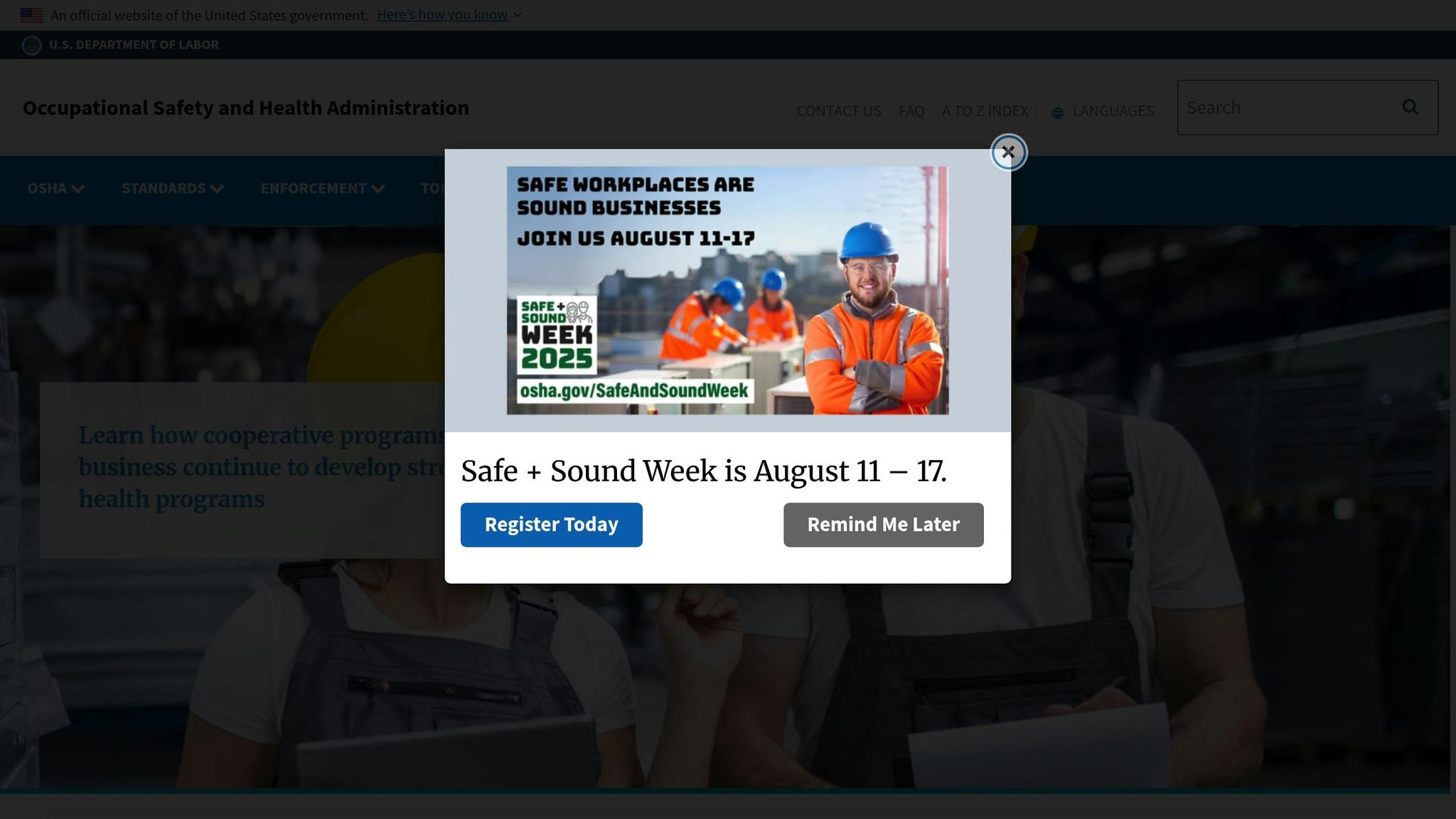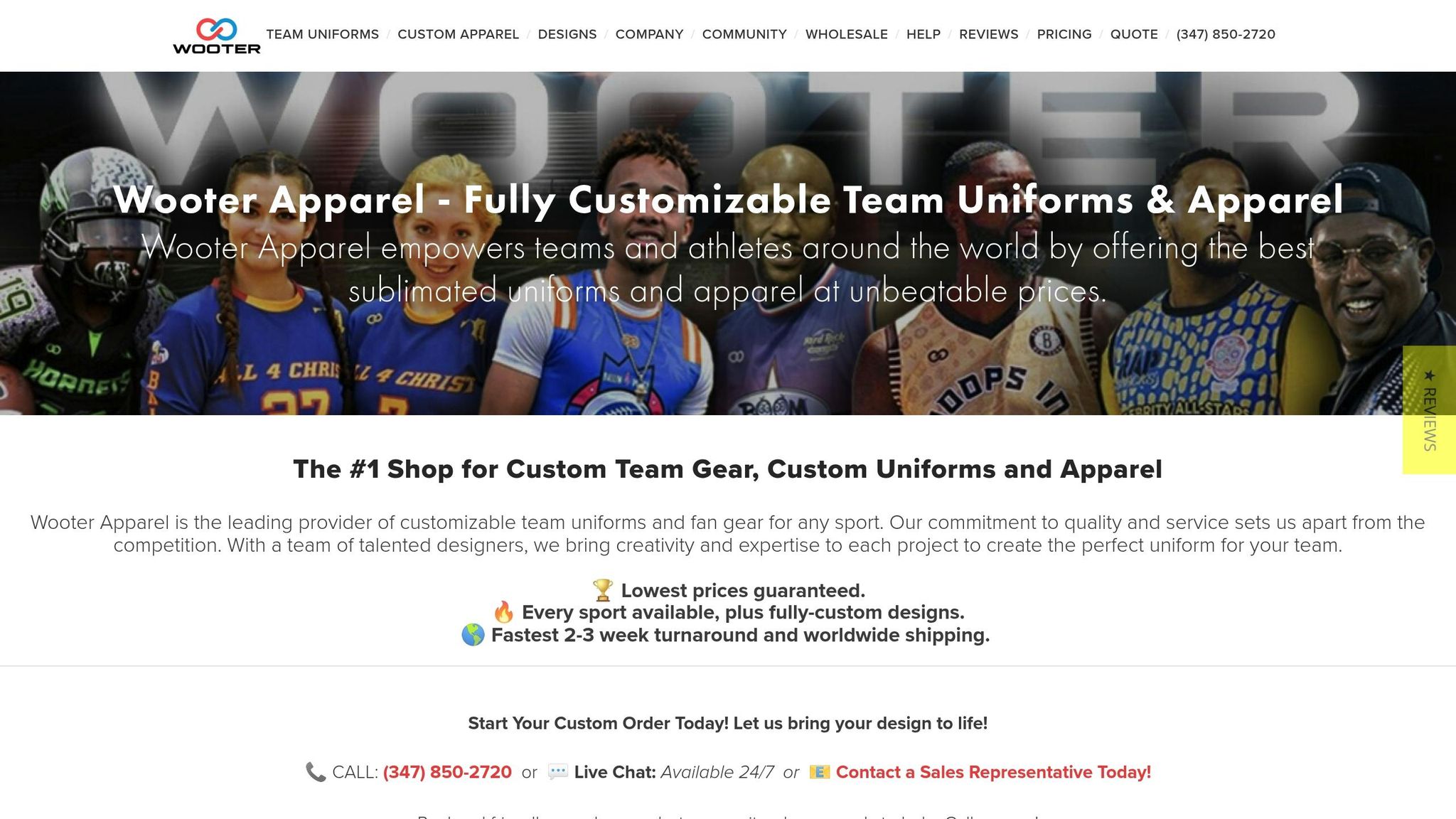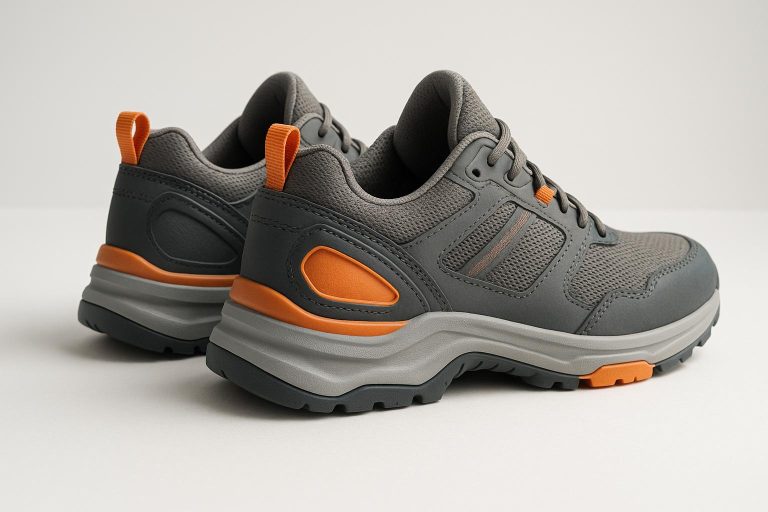Designing sports footwear that meets safety standards is about balancing protection, performance, and comfort. Here’s what you need to know:
- Safety Standards Matter: Footwear must comply with OSHA regulations like 29 CFR 1910.136 and ASTM standards (F2412 and F2413) to protect against impact, compression, punctures, and electrical hazards.
- Key Features: Slip-resistant outsoles, toe caps (steel, aluminum, or composite), and shock-absorbing materials are essential. Flexibility, breathability, and proper weight distribution ensure comfort without compromising safety.
- Testing and Certification: Rigorous testing for impact, compression, and other hazards is required. Labels like "ASTM F2413-24" indicate compliance and protection levels.
- Customization for Teams: Branding options like woven labels or heat transfer printing allow teams to maintain their identity while meeting safety requirements.
Bottom Line: Safety-compliant footwear protects athletes from injuries, supports performance, and adheres to strict safety regulations. The process involves hazard assessments, material selection, and thorough testing to ensure both safety and comfort.
2022 Safety Footwear Standards Explained
U.S. Safety Regulations for Sports Footwear
When it comes to safety footwear in the United States, federal regulations and industry standards work together to ensure athletes are protected in various environments. For designers of sports footwear, understanding these rules is essential to creating products that meet both legal and performance expectations.
Regulatory Bodies and Standards
The Occupational Safety and Health Administration (OSHA) provides the legal framework for workplace safety, including rules for foot protection. Specifically, OSHA’s regulation 29 CFR 1910.136 mandates the use of protective footwear in environments where risks like falling objects, sharp objects, or electrical hazards are present. However, OSHA doesn’t create its own testing criteria. Instead, it relies on widely accepted industry standards to define how safety footwear should perform.
Two key standards OSHA recognizes are ASTM F2412 and ASTM F2413. Here’s the breakdown:
- ASTM F2412: Specifies the testing methods manufacturers must use to evaluate safety footwear.
- ASTM F2413: Establishes the minimum performance requirements the footwear must meet.
In simple terms, OSHA sets the rules, while ASTM provides the technical details that make compliance measurable.
Decoding Compliance Labels
Labels on safety footwear are more than just tags – they’re a quick way to understand what protection the shoes offer. For example, a label like "ASTM F2413-24 M/I/C/EH" tells you the footwear complies with the 2024 standard, is sized for men, and provides protection against impact (I), compression (C), and electrical hazards (EH).
Some key markings include:
- I/75: Protects against impacts up to a 75-pound force, the highest level in the latest ASTM F2413 standard.
- C/75: Guards against compression from rolling objects weighing up to 2,500 pounds.
- Mt/75: Offers metatarsal protection, shielding the top of the foot from 75-pound impacts.
- PR: Indicates puncture resistance.
- SD: Refers to static dissipative properties, crucial in static-sensitive environments.
- Cd: Stands for conductive properties, designed for use in flammable or explosive settings.
For electrical hazards, EH-rated footwear must withstand 18,000 volts at 60 hertz for one minute, with current leakage not exceeding 1.0 milliampere under dry conditions. This ensures protection against open circuits up to 600 volts in dry environments .
These labels connect the legal requirements to the specific design features of the footwear, making it easier for users to choose the right product for their needs.
OSHA vs. ASTM: How They Work Together

Although OSHA and ASTM play different roles, they complement each other in ensuring safety. OSHA establishes the legal requirements, while ASTM defines the technical standards that make those requirements actionable.
| Protection Type | OSHA Requirement | ASTM Standard | Performance Level |
|---|---|---|---|
| Impact Resistance | Required for falling object hazards | ASTM F2413 (I) | Protects against up to 75-pound force |
| Compression Resistance | Required for rolling object hazards | ASTM F2413 (C) | Handles up to 2,500-pound compression |
| Electrical Hazard | Required for shock risks | ASTM F2413 (EH) | 18,000 volts for 1 minute; ≤1.0 mA leakage |
| Puncture Resistance | Required for sharp object hazards | ASTM F2413 (PR) | Protects against sole penetration |
| Metatarsal Protection | Required for top-of-foot hazards | ASTM F2413 (Mt) | Shields against 75-pound force impacts |
| Static Dissipation | Required in static-sensitive environments | ASTM F2413 (SD) | Controls static electricity discharge |
This table highlights how OSHA’s mandates and ASTM’s standards work hand in hand. OSHA’s rules are legally binding and subject to workplace inspections, while ASTM standards, though voluntary on their own, become mandatory when OSHA references them. Together, they ensure that safety footwear for sports and other demanding environments meets consistent, measurable criteria. For designers, this means balancing legal compliance with technical precision to create footwear that genuinely protects athletes.
Design Features for Safety-Compliant Sports Footwear
Creating sports footwear that meets safety standards while delivering top-notch athletic performance is no small feat. The key is weaving protective features into the design without sacrificing comfort or functionality.
Protective Components and Materials
A solid foundation for safety starts with slip-resistant outsoles. By using specialized rubber compounds and tread patterns, these soles reduce the risk of slips and falls, even on wet or uneven surfaces.
For shock absorption, closed-cell foam is an excellent choice. This material can handle repeated impacts while maintaining resilience, making it ideal for the high demands of various sports.
These materials form the backbone of a design that prioritizes both safety and comfort, ensuring athletes can perform at their best without worry.
Balancing Safety and Comfort
Striking the right balance between protective features and athletic performance requires a thoughtful approach. One major consideration is weight distribution. Adding safety components can increase weight, so distributing it effectively is essential to avoid hindering movement.
Breathability is another critical factor. Incorporating mesh panels, moisture-wicking linings, and ventilation channels can help manage heat and moisture, keeping feet cool and dry without compromising safety.
Flexibility is just as important as protection. Research shows that footwear that’s either too stiff or overly flexible can lead to increased muscle strain and quicker fatigue. A smart design includes rigid protective zones where needed, while ensuring flexibility in areas that allow natural movement.
Comfort is further enhanced through ergonomic designs that work with the body’s movements. Features like dual-density midsoles offer a blend of support and cushioning, while adjustable closures, proper arch support, and a broader base ensure a secure fit that meets safety requirements.
Lastly, confidence plays a big role. Athletes are far more likely to wear safety-compliant footwear consistently if it feels good and fits well. This not only boosts performance but also ensures adherence to safety standards, such as ASTM F2413 guidelines. By integrating these thoughtful design elements, sports footwear can achieve the perfect synergy of safety, comfort, and performance.
sbb-itb-4d95ad3
Step-by-Step Guide to Designing Safety-Compliant Sports Footwear
Creating sports footwear that meets safety standards involves a structured process. By following these three steps, you can design footwear that not only protects athletes but also meets regulatory requirements.
Conducting a Hazard Assessment
Every safety-compliant design begins with identifying the specific risks athletes may encounter. A detailed hazard assessment pinpoints the dangers your footwear needs to address.
"The employer shall assess the workplace to determine if hazards are present, or are likely to be present, which necessitate the use of personal protective equipment (PPE)." – OSHA Standard 29 CFR 1910.132(d)
To conduct a hazard assessment, focus on these key questions:
- What are the hazards? Identify sport-specific risks like sharp objects on fields or electrical hazards in certain facilities.
- Who might be harmed and how? Think about the roles of different athletes, their environments, and activity levels.
- How severe are the risks, and what protection is needed? Use this evaluation to determine the level of protection your design should provide.
OSHA mandates that hazard assessments be documented, with written certification confirming the evaluation has been completed. These assessments should be updated regularly, especially when new conditions, equipment, or team members are introduced. For instance, in December 2013, OSHA clarified that safety-toe footwear could be required if a hazard assessment identified relevant risks.
Selecting Materials and Features
Once hazards are identified, the next step is choosing materials and design elements that address these risks effectively. Footwear materials must accommodate the foot’s complex structure while ensuring safety.
Material selection depends on the intended environment and activities. For example:
- Steel toe caps provide reliable impact protection but add weight.
- Aluminum or composite toe caps reduce weight but may increase bulk.
- Composite toe designs are non-metallic, resistant to extreme temperatures, and meet ASTM safety standards.
Outsole materials also play a crucial role. Genuine rubber offers excellent resistance to abrasion, oil, and slips, while TPU, PU, and EVA materials are lighter and provide better cushioning. For added durability, leather can be reinforced with a thin polyurethane layer to maintain its natural properties while enhancing strength.
When testing for fit, always use the padded socks athletes typically wear. Balancing comfort and durability is key – harder materials may last longer but sacrifice initial comfort, while softer materials prioritize comfort but wear out faster. High-performance designs may include advanced technologies for speed and efficiency, though these features can sometimes reduce durability.
| Material Type | Advantages | Considerations |
|---|---|---|
| Steel Toe Caps | Strong protection, proven durability | Heavier, can transfer cold |
| Composite Toe Caps | Lightweight, non-conductive, temperature-resistant | May be bulkier than steel alternatives |
| Genuine Rubber Outsoles | Superior slip, oil, and abrasion resistance | Heavier compared to synthetic options |
| TPU/PU/EVA Outsoles | Lightweight, flexible, enhanced cushioning | May compromise some durability |
Testing and Certifying Footwear
After selecting materials and features, rigorous testing ensures the footwear meets safety standards. Certification is the final step to confirm compliance.
"Safety footwear is designed to provide protection to the feet in various hazardous situations, but it is essential to ensure that these shoes are effective in doing so." – Peter Goodwin, Technical Specialist at James Heal
OSHA recognizes ASTM F2413 as the standard for safety footwear in U.S. workplaces, alongside ASTM F2412, which outlines testing procedures for impact, compression, and puncture resistance, among other safety features.
A thorough testing process should include:
- Physical Testing: Assess impact resistance, compression strength, and puncture protection.
- Chemical Testing: Verify material integrity under expected conditions.
- Fit and Comfort Testing: Ensure safety features don’t compromise wearability.
- Inspection: Confirm manufacturing consistency.
Certified safety shoes are labeled with codes indicating their protection levels. Common ASTM markings include:
- I/75 for impact resistance (75 ft-lb)
- C/75 for compression resistance (2,500 lbs)
- EH for electrical hazard protection
- Mt/75 for metatarsal protection
- PR for puncture resistance
- SD for static dissipative properties
- Cd for conductive properties
Footwear labeled "ASTM F2413-18" or "ASTM F2413-24" has passed required tests and is approved under OSHA regulations. Certification services from organizations like QIMA and Hohenstein provide comprehensive evaluations to verify safety, quality, and compliance.
Maintain detailed records throughout the testing process. Proper documentation – from hazard assessments to certifications – not only demonstrates due diligence but also helps with future design improvements and addresses potential warranty or liability issues.
Adding Safety Footwear to Custom Team Uniforms
Safety-compliant sports footwear doesn’t have to mean giving up team identity. With modern techniques, teams can maintain their branding while meeting necessary protection standards. The key is understanding which design elements can be adjusted without affecting safety certifications.
Customizing for Team Branding
Incorporating team branding into safety footwear involves carefully choosing placement and customization methods. Here are some of the most common options:
- Silk Screen Printing: Best for large orders with simple, single-color logos, this method is durable and budget-friendly.
- Heat Transfer Printing: Ideal for smaller batches with detailed, multi-color designs, though it offers slightly less durability.
- Drop Plastic Labels: These create a raised, three-dimensional look and are highly resistant to wear and water, making them great for harsh environments. However, they come at a higher cost.
- Woven Labels: Known for their premium appearance and exceptional durability, these are perfect for mid- to high-end applications, though they’re less suited for very intricate designs.
Here’s a quick comparison of these methods:
| Customization Method | Best For | Durability | Cost | Design Complexity |
|---|---|---|---|---|
| Silk Screen Printing | Large orders, simple logos | High | Low | Simple, monochrome |
| Heat Transfer Printing | Small batches, detailed designs | Medium | Medium | High, multi-color |
| Drop Plastic Labels | 3D effects, harsh conditions | Very High | High | Simple to medium |
| Woven Labels | Premium appearance and durability | Highest | High | Simple to medium |
Choosing the right method depends on your design’s complexity, your budget, and how much wear and tear the footwear will face. If sustainability is a priority, eco-friendly options can also align with corporate social responsibility goals.
These branding techniques pave the way for creating cohesive team gear that’s both functional and stylish.
Using Wooter Apparel for Custom Solutions

Wooter Apparel takes these customization methods a step further, offering tailored solutions that blend safety and style. Their fully sublimated designs ensure team aesthetics extend seamlessly to safety footwear. By coordinating colors and materials, they create uniforms that are not only protective but also visually cohesive and performance-driven.
Sustainability is becoming a bigger priority in team apparel. Many teams now opt for safety footwear made from biodegradable materials, recycled plastics, and eco-conscious production methods. This approach helps balance environmental responsibility with the need for high-quality gear.
By integrating safety footwear into custom uniforms, teams can maintain a professional and unified look without compromising on protection. Matching footwear colors with uniform designs while keeping essential safety features intact ensures a polished image that prioritizes both style and safety.
The growing demand for high-quality, integrated gear highlights the importance of meeting both protective standards and aesthetic expectations.
Conclusion: Key Points for Designing Safety-Compliant Sports Footwear
Creating sports footwear that meets safety standards requires balancing protection, performance, and style. The process starts with a thorough hazard assessment to identify the specific risks associated with each sport.
Materials play a critical role and must comply with ASTM F2412 and F2413 standards while still offering the comfort and breathability athletes need. The real challenge is finding materials that provide robust protection without compromising these essential qualities.
Testing and certification are non-negotiable steps in this process. Rigorous testing for impact, compression, electrical, slip, and puncture resistance ensures compliance with safety standards. Submitting footwear samples to authorized testing labs not only confirms compliance but also provides the necessary documentation for entering the market confidently.
Quality control at every stage of manufacturing is equally important. Keeping detailed records of materials, production processes, and quality checks ensures regulatory compliance and helps catch potential issues before they reach the consumer. This approach safeguards both the product’s safety and the brand’s reputation.
Clear and accurate labeling is another key aspect. Labels should communicate the footwear’s compliance with safety standards and include user instructions to maximize protection. At the same time, these labels can incorporate team branding, blending style with functionality. Companies like Wooter Apparel have shown how modern sublimation techniques can combine team identity with safety-compliant designs.
FAQs
What are the differences between steel, aluminum, and composite toe caps in sports footwear when it comes to safety and comfort?
When it comes to toe caps, each material has its pros and cons depending on your needs.
Steel toe caps are known for offering top-notch protection against impact and compression, making them a solid choice for high-risk environments. But with that durability comes added weight, which can make them less comfortable if you’re wearing them for long hours.
Aluminum toe caps strike a balance between safety and comfort. They’re lighter than steel and won’t rust, making them a smart pick for work in damp or wet conditions. However, they don’t quite match the toughness of steel when it comes to withstanding extreme forces.
If comfort is your top priority, composite toe caps are the way to go. They’re the lightest option, offering reliable impact resistance (up to 75 pounds) and are completely non-metallic – perfect for jobs where metal detectors are an issue. That said, they might not provide the same level of protection as steel in the most hazardous situations.
How can sports teams add their branding to safety-compliant footwear without compromising safety standards?
Sports teams can add a touch of their identity to safety-compliant footwear by integrating team colors, logos, or patterns into the design. However, it’s crucial that these customizations don’t compromise the protective features required by U.S. safety standards, like reinforced toes, slip-resistant soles, and durable materials.
Collaborating with manufacturers or customization experts who specialize in sports footwear can make this process smoother. For instance, branding details can be incorporated using approved methods during production, ensuring the shoes remain both protective and stylish. This way, players stay safe while proudly showcasing their team spirit.
What tests are required to ensure sports footwear meets OSHA and ASTM safety standards?
To meet OSHA and ASTM safety standards, sports footwear manufacturers must put their products through a series of rigorous tests. One such test is impact testing, where a 50-pound weight is dropped from a height of 18 inches to simulate a force of 75 ft-lbs. Another critical evaluation is the compression test, which assesses how well the footwear holds up under heavy loads.
Other assessments may include metatarsal protection tests, designed to safeguard the top of the foot, and electrical hazard testing, which ensures the shoes provide adequate safety in environments with electrical risks.
These evaluations play a crucial role in producing footwear that not only meets regulatory requirements but also offers athletes dependable protection, whether they’re on the field or off.

